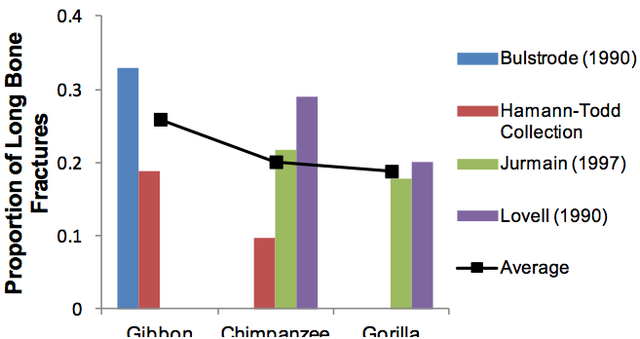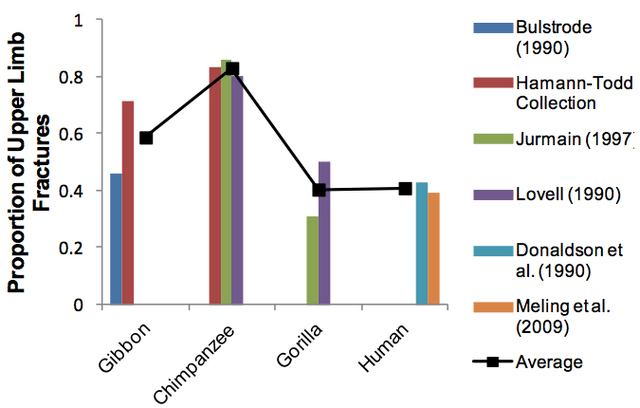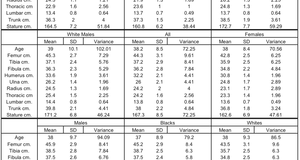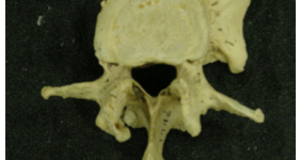From Discussions VOL. 8 NO. 2Ape Fracture Patterns Show Higher Incidence in More Arboreal Species
IN THIS ARTICLE
KEYWORDS
AbstractIn the following study, the Hamann-Todd Osteological Collection at the Cleveland Museum of Natural History was examined to compare long bone fracture incidence among wildshot chimpanzees (Pan troglodytes), gibbons (Hylobates lar), and lowland gorillas (Gorilla gorilla). The initial hypothesis was that the more arboreal species, the chimpanzees and gibbons, would have greater incidence of longbone fractures as a consequence of spending more time in an arboreal environment and the associated increased risk of falling. First, the percentages of individuals that had long bone fractures, including fractures of the radius, ulna, humerus, tibia, fibula, and femur, out of the total population for each species were compared. Additionally, among those individuals with long bone fractures the percentages that had long bone fractures of specifically the upper limb were compared among species. The results showed a general trend toward higher incidence in long bone fractures among the more arboreal species. However, comparison of proportions of upper limb fractures shows that chimpanzees have the highest ratio of upper to lower limb fracture, followed by gibbons, and then followed by both humans and gorillas. These findings do not appear to correlate to time spent in the trees but may be caused by other factors such as bone strength, behavioral adaptations, and possible selection bias. Apes suffer a very high fracture incidence as a result of their arboreal lifestyles, but since there is such an enormous risk associated with this form of locomotion, there must be great evolutionary advantage to outweigh the cost. Analysis of these fracture patterns gives insight into behavior, adaptation, and evolution of apes. For the great apes in the wild, long bone fractures can be devastating, and their occurrence is an important factor in evolution. Since one likely cause of long bone fractures is falls, the hypothesis was that more arboreal primates would show greater fracture incidence. Since the upper limb is longer than the lower limb in apes, the upper limb was expected to sustain a greater proportion of the fractures. Differences in the proportions of upper limb bone fractures could elucidate how the apes vary in the causes for long bone fractures. In this study, the proportion of individuals with long bone fractures and the proportion of upper limb fractures were compared in Pan troglodytes and Hylobates in samples from the Hamann-Todd Osteological Collection at the Cleveland Museum of Natural History. These data were compared to previous literature on different collections of gibbons, chimpanzees, gorillas, and humans. The differences between these apes' behavior and physiology, based on their divergent evolutionary histories, should elucidate the underlying causes for differences in fracture incidence and distribution. Materials and MethodsData were collected from the Hamann-Todd Collection at the Cleveland Museum of History using gibbons and chimpanzees. The specimens' long bones were analyzed for fractures, with 37 gibbons and 62 chimpanzees sampled. Data were also obtained from a study by Robert Jurmain (1997) involving investigation of skeletons of chimpanzees and gorillas for traumatic injuries. Lovell (1990) also studied chimpanzee and gorilla fractures, using a sample from the National Museum of Natural History in Washington D.C. Bulstrode (1990) sampled wild gibbons for fractures. Human samples were obtained from Donaldson and colleagues (1990) and Meling and colleagues (2009). ResultsFor the data sampled from the Hamann-Todd Collection, 7/37 (18.9%) of the gibbons had long bone fractures, and 6/62 (9.7%) of the chimpanzees had long bone fractures. Using the values obtained from this study and previously published data, averages were calculated. The averages were 26.0% for gibbons, 20.1% for chimpanzees, and 18.9% for gorillas (Figure 1). Jurmain also saw a difference in gender ratios, where males had a higher fracture incidence in chimpanzees, whereas females had higher fracture incidence in gorillas (1997). The data collected from the Hamann-Todd Collection shows lower levels of overall fracture incidence in both gibbons and chimpanzees than expected, since the literature values for both are higher. The incidence may have been lower due to a small sample size. However, within each study, the relative proportions show the expected trend. For the HamannTodd collection, gibbons show greater rate of fractures than chimpanzees. In Jurmain's study (1997) and Lovell's study (1990), chimpanzees show higher rate of fractures than gorillas. The study by Bulstrode (1990) shows that gibbons have a higher rate of fracture than chimpanzees and gorillas. Figure 1. Incidence of long bone fractures in gibbons, chimpanzees, and gorillas. While the values, particularly for chimpanzees, vary among studies, the averages show that the more arboreal animals, shown decreasing from left to right, incur a higher proportion of fractures.
Figure 2. Proportion of long bone fractures that occur in the upper limb for samples of gibbons, chimpanzees, gorillas, and humans, shown decreasing in arboreality from left to right. Chimpanzees show the highest proportion of upper limb fractures, followed by gibbons. Gorillas and humans have a lower proportion of upper limb fractures.
The percentage of long bone fractures that occurred in the upper limb out of those individuals with fractures was calculated using their data and graphed (Figure 2). The Hamann-Todd Collection had 5/7 (71.4%) upper limb fractures in gibbons compared to 5/6 (83.3%) in chimpanzees. The averages, using values from published data and the Hamann-Todd Collection, gave a value of 58.7% for gibbons, 83.0% for chimpanzees, 40.4% in gorillas, and 40.9% in humans. The data show that for chimpanzees a substantially higher percentage of their fractured long bones occur in the upper limb, as compared with both gorillas and humans. Gibbons had a lower proportion of upper limb fractures than chimpanzees but generally higher than gorillas and humans.Continued on Next Page » Suggested Reading from Inquiries Journal
Inquiries Journal provides undergraduate and graduate students around the world a platform for the wide dissemination of academic work over a range of core disciplines. Representing the work of students from hundreds of institutions around the globe, Inquiries Journal's large database of academic articles is completely free. Learn more | Blog | Submit Latest in Biology |



















